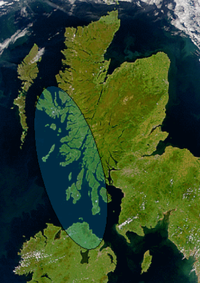Gaels of Scotland
| Total population | |
|---|---|
| Languages | |
| Scottish Gaelic (Non-Gaelic: English · Scots) | |
| Religion | |
| Presbyterianism, Roman Catholic, Episcopalianism | |
| Related ethnic groups | |
| Picts, Scottish people |
The Gaels of Scotland or, simply Gaels, (Scottish Gaelic: Na Gàidheil) are an ethnolinguistic group found in Scotland – including the land of their origins, the Scottish Highlands (Scottish Gaelic: A' Gàidhealtachd) – and in the diaspora of Scotland within the United States, Canada, Australia and New Zealand.[2] The Gaels as an ethno-linguistic group can also be found in Ireland and the Isle of Man.
Gaelic[edit]
Within Scotland the term Gaelic most often refers to the Scots Gaelic language (Scottish Gaelic: Gàidhlig); however, it can also refer to the broader linguistic Goidelic group of Gaels – analogous with Hispanic (or Iberian) – that comprises the inhabitants the nations of Scotland, Ireland and the Isle of Man (Scottish Gaelic: cànanan Goidhealach). In Ireland the term is pronounced slightly differently.

History[edit]
The Scots Gaels derive from the overkingdom of Dál Riata, which generated various explanations of its origins, including a foundation myth of an invasion from Ireland and a more recent archaeological and linguistic analysis that points to a pre-existing maritime province united by the sea and isolated from the rest of Scotland by the mountainous ridge called the Druim Alban.[3][4] The archaeological evidence relates to Ireland while the linguistic evidence relates to Scotland, absent any evidence of conflict either in that exchange or in the erasing of pre-existing culture within that exchange.[clarification needed] The cultural exchange includes passage of the M222 genotype within Scotland.[5]

The ethnolinguistic group expanded with the creation of the Kingdom of Alba, subsuming within it the previously Brittonic-speaking Picts.
A similar pattern of expansion into the Brittonic Kingdom of Strathclyde and the Kingdom of Galloway occurred - although the latter had previously been subsumed into the Norse-Gael Irish Sea and Scottish Sea[clarification needed] regions created at the same time the Vikings cut off the islands of Argyll and the Hebrides from the Kingdom of Alba. Galwegian Gaelic survived until 1760, whilst Strathclyde's transition is less well documented despite linguistic certainty that it became a Gaelic language region.
The assimilation of Strathclyde into what then become known as the Kingdom of Scotland - Scots (deriving from Scoti) becoming a demonym for Dál Riata - marks the highpoint of the Scots Gaels in Scotland, as the adjacent Anglo-Saxon dominated region of the previously Brittonic Lothian gradually exported an Anglo-Saxon language that became known as the Scots language into Scotland when it too accepted the superiority of the Scots Gael Kingship.
The expansion of the Scots Gael Kingship ended as such with the beginnings of the Scoto-Norman Royal House period that gradually - and with no deep personal connection to the origins of the Kingship in Dál Riata or the Kingdom of Alba - lost Scots Gaelic as its tongue. However, the Kingship eventually united the Kingdom of Scotland with the Kingdom of England.
The Highland - Lowland divide that henceforth took root meant survival of the Scots Gaelic language and a reemergence of Gaelic identity - where previously it was broadly Scottish - as Scotland's Kingship took the Anglo-Saxon derived Scots language as its tongue. Mary Queen of Scots was the last monarch who ruled with the historically given title of Scots that linked the monarchy with the ethnolinguistic group, while her grandfather James IV was the last known Gaelic language monarch.
With the culturally devastating Highland Clearances, the spread of the Scots Gael diaspora into the region of the former British Empire has meant that Scots Gaelic is currently a transatlantic language (see Canadian Gaelic) while the diaspora covered a much wider area. In the early 21st century, the descendants of the Highland diaspora far outnumber the population in Scotland.
References[edit]
- ↑ 2011 Census of Scotland, Table QS211SC. Viewed 30 May 2014.
- ↑ Moffat, Alistair; Wilson, James (2017). "Northwards". The Scots: A Genetic Journey. Birrlin. Search this book on

- ↑ "How British is Scotland? Archaeological Origins of Scotland". Centre for Scottish and Celtic Studies. 26 January 2015.
- ↑ Campbell, Ewan. "Were the Scots Irish?" in Antiquity No. 75 (2001). pp. 285–292.
- ↑ "Scotland's DNA: Tartan export". The Scotsman. 3 March 2011. Retrieved 30 October 2017.
This article "Gaels of Scotland" is from Wikipedia. The list of its authors can be seen in its historical and/or the page Edithistory:Gaels of Scotland. Articles copied from Draft Namespace on Wikipedia could be seen on the Draft Namespace of Wikipedia and not main one.
